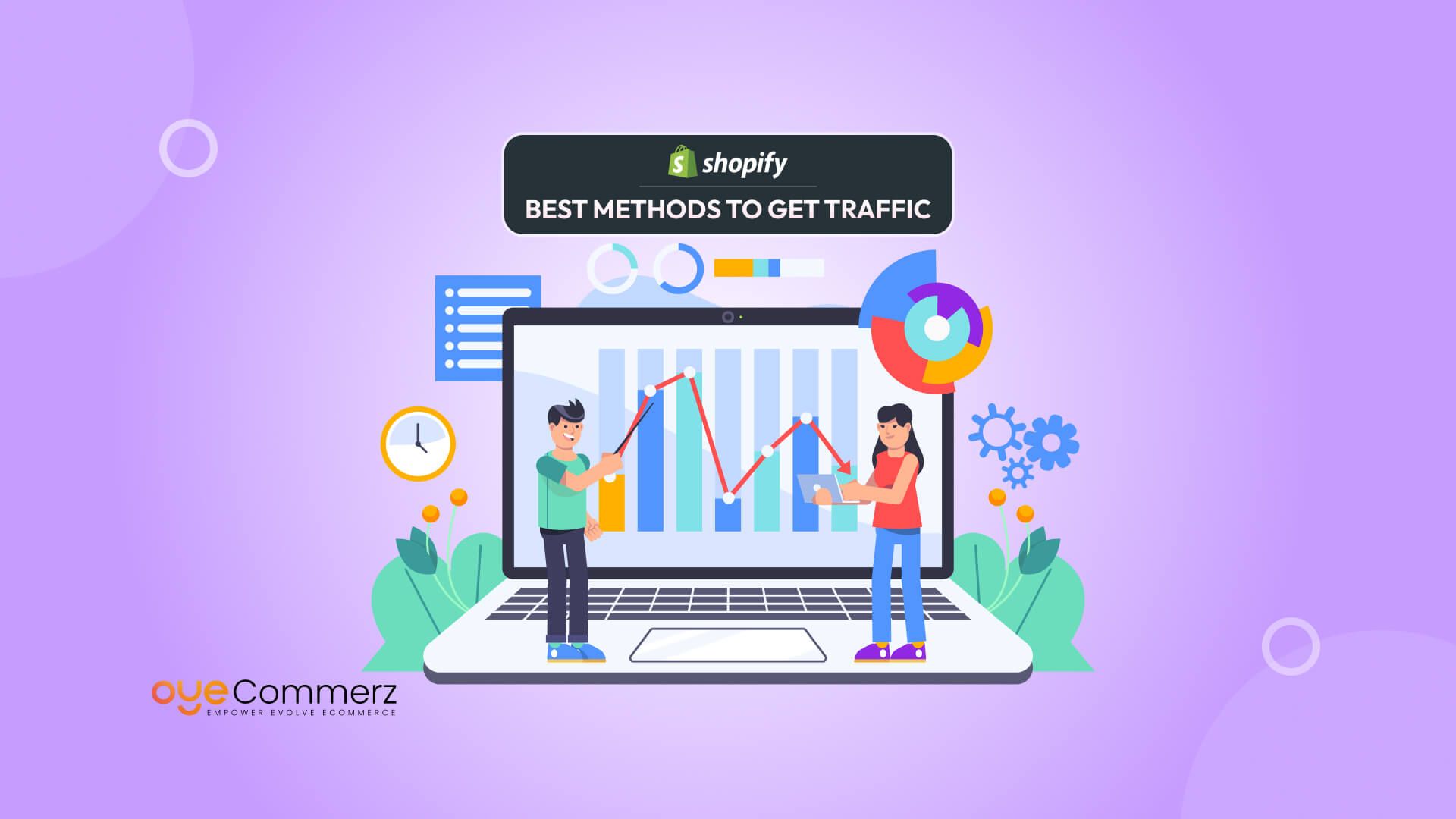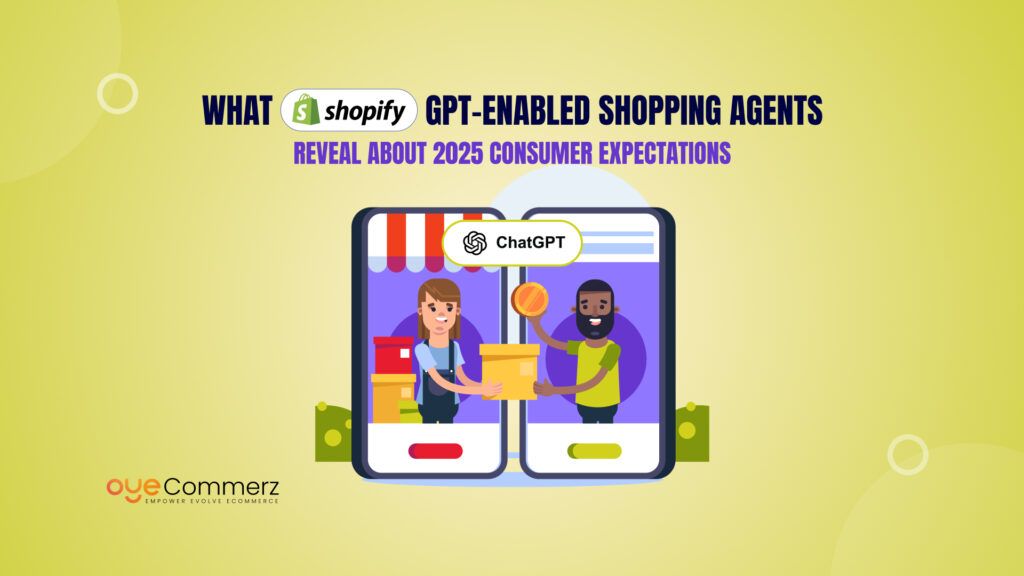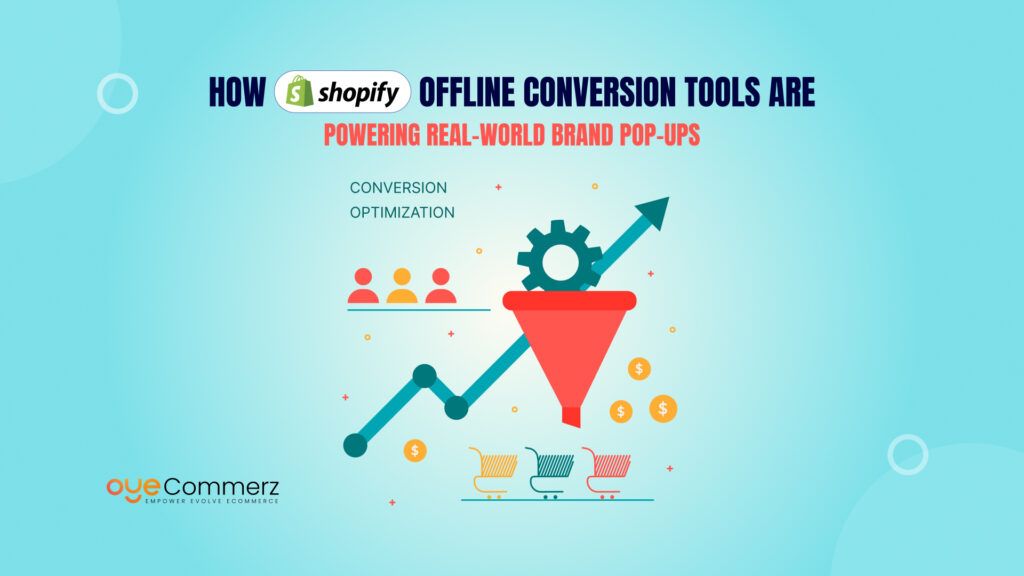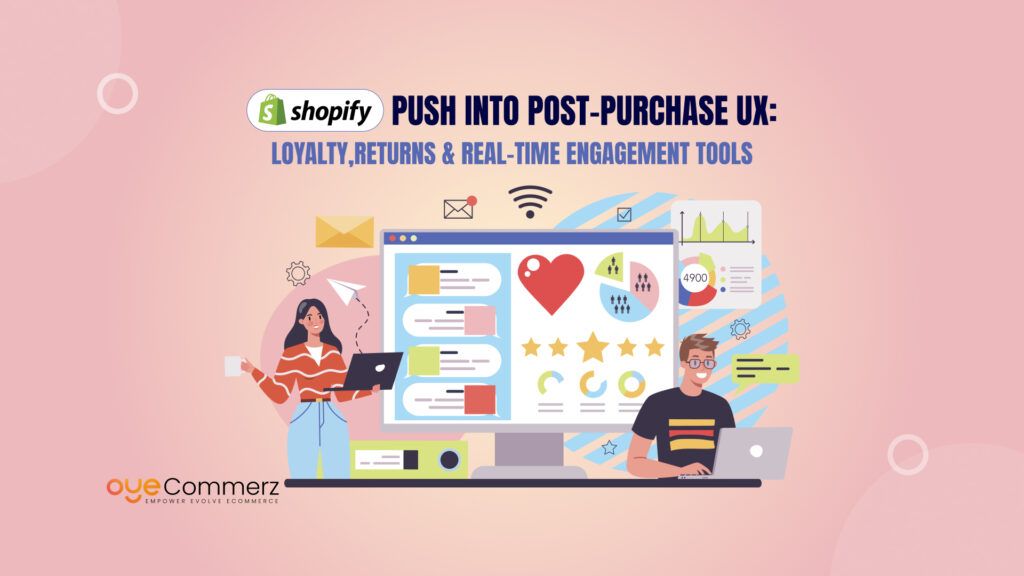Did you know that 90% of eCommerce startups fail within the first 120 days, often due to a lack of website traffic? Launching a new Shopify store is exciting, but getting people to visit and buy is the real challenge. With no brand recognition or audience, many store owners struggle to gain momentum after launch. But don’t worry there are proven ways to drive traffic, including smart use of SEO services that help your store rank on search engines. In this blog, we’ll explore the best free and paid methods to get traffic on your new shopify store and grow your reach.
Table of Contents
ToggleOrganic Traffic Strategies (Free, Long-Term)
When starting a Shopify store, organic traffic should be your foundation. It may take time, but once established, it brings a steady stream of potential buyers without paying for every click. Here are the best long-term organic methods to grow your Shopify store’s visibility:
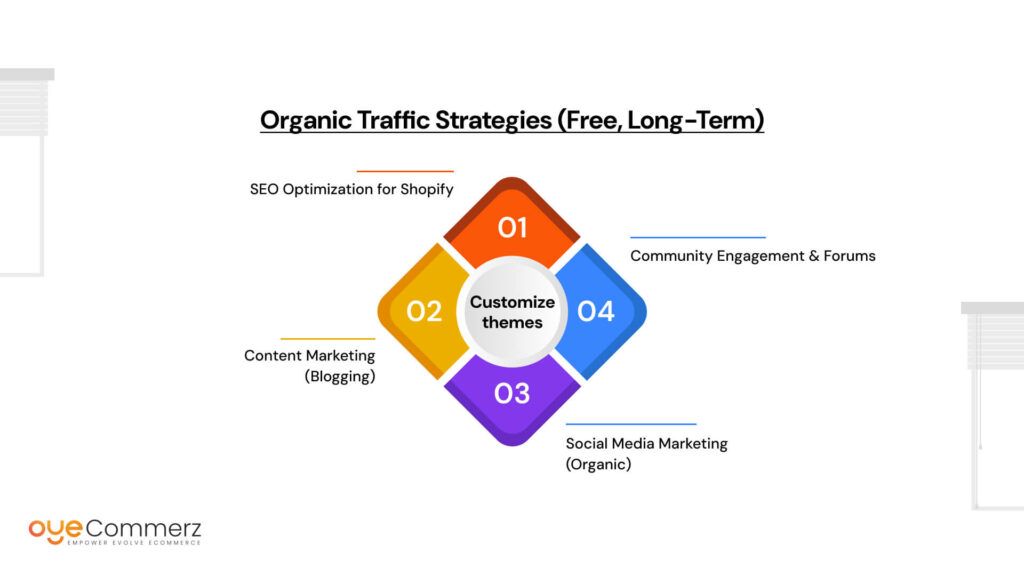
1. SEO Optimization for Shopify
If you want your store to be discovered on Google, SEO is non-negotiable.
Start with keyword research and focus on long-tail keywords that reflect how your ideal customer searches. For example, instead of just “t-shirts,” aim for “organic cotton graphic t-shirts for men.”
Next, work on on-page SEO:
- Write keyword-rich titles and meta descriptions
- Use clean, descriptive URLs
- Add ALT text to all images
- Structure product pages with headers and internal links
To make the process easier, leverage Shopify SEO tools and apps like Plug In SEO, Smart SEO, or SEO Manager to scan your store and provide actionable recommendations.
2. Content Marketing (Blogging)
Blogging isn’t just for writers, it’s a powerful traffic magnet when used strategically.
Why it matters:
Search engines love fresh, relevant content. A blog allows you to target informational keywords that attract potential customers early in their buying journey.
Content ideas to get you started:
- “How to Choose the Right [Product Type]”
- “Top 5 [Product Category] for [Season/Event]”
- Customer stories or behind-the-scenes insights
Use Shopify’s built-in blog feature to publish regularly, and always optimize your posts for SEO by including internal links, keyword variations, and clear CTAs.
3. Social Media Marketing (Organic)
Organic social media helps you build community and brand personality.
Start by choosing the right platforms for your niche:
- Instagram and TikTok for fashion, beauty, and lifestyle
- Pinterest for home décor, DIY, or wedding-related products
- Facebook for broader audience engagement
Focus on creating a strong brand voice consistent, authentic, and visually appealing. Post a mix of behind-the-scenes content, customer reviews, and product features.
Use shoppable posts and reels to link your social media directly to your Shopify store and make it easy for users to buy without leaving the app.
4. Community Engagement & Forums
Joining online communities is a smart way to drive traffic while building trust.
Platforms like Reddit, Quora, and Facebook Groups are full of niche audiences looking for solutions. Become a helpful contributor by answering questions, sharing insights, and subtly recommending your products when relevant.
The golden rule? Give value before you promote.
People respond to helpful, authentic advice, not pushy sales pitches. Over time, this builds authority and brings in engaged traffic.
Paid Traffic Strategies (Fast, Scalable)
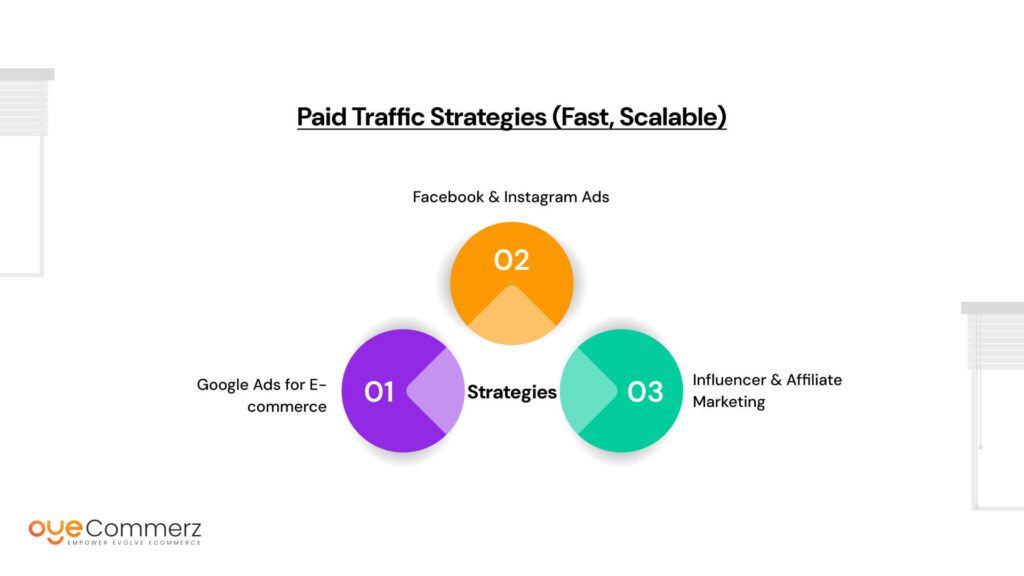
While organic methods are essential for long-term growth, paid traffic offers immediate visibility and faster results. If you’ve got a marketing budget, these strategies can help drive high-intent visitors to your Shopify store fast.
5. Google Ads for E-commerce
When shoppers are actively searching for products, Google is often their first stop. This makes Google Ads one of the most powerful tools for Shopify store owners.
Start with Google Shopping Ads, which display your products directly in search results with images, pricing, and store name perfect for capturing high purchase intent.
Also, run branded search campaigns to ensure your store shows up when someone types your brand name or related terms.
Geo-targeting and smart bidding strategies can help you reach local audiences or test markets without overspending. Use Google Ads’ automated bidding tools to optimize for conversions, and keep refining your keywords and product feed for best results.
6. Facebook & Instagram Ads
Facebook and Instagram offer unmatched targeting capabilities for e-commerce businesses. With billions of active users, these platforms allow you to put your products in front of your ideal audience based on interests, behaviors, and demographics.
Create high-quality ad creatives using lifestyle images, short videos, or user-generated content to build trust. Pair that with clear, benefits-driven ad copy that speaks to your target customer.
Don’t forget to set up retargeting campaigns. These ads are shown to visitors who previously browsed your store or abandoned their cart, making them much more likely to convert the second time around.
7. Influencer & Affiliate Marketing
Paid traffic doesn’t always mean running ads. Partnering with influencers or affiliates can generate quality traffic and sales while building social proof.
Start by collaborating with micro and mid-tier influencers in your niche. They often have more engaged communities and charge less compared to celebrity influencers. Provide them with free products or commission-based incentives.
For longer-term scalability, set up an affiliate program using Shopify apps like Refersion, UpPromote, or Affiliatly. Affiliates promote your store in exchange for a percentage of each sale, making it a low-risk way to grow your reach.
List-Building & Retention Channels
Getting traffic is just the beginning, keeping it and converting it is where real growth happens. Building an email list and encouraging referrals are key to maximizing the value of each visitor. These strategies help you retain customers, increase lifetime value, and build a loyal community around your brand.
8. Email Marketing
Email remains one of the highest-ROI marketing channels for eCommerce. It allows you to nurture leads, recover abandoned carts, and keep customers engaged long after their first visit.
Start by capturing leads with well-timed popups or banners offering an incentive think 10% off, a freebie, or early access to new products. Make it easy for visitors to subscribe by keeping forms short and mobile-friendly.
Use tools like Klaviyo or Omnisend, which integrate seamlessly with Shopify and offer powerful automation features. Once set up, focus on:
- Welcome sequences to onboard new subscribers
- Abandoned cart emails to recover lost sales
- Product recommendation flows to encourage repeat purchases
The goal? Deliver value consistently, not just promotions.
9. Referral Programs & Word-of-Mouth
One of the most trusted sources of new traffic is your existing customers. When people love your products, they’re more than happy to spread the word especially with a little incentive.
Encourage referrals by offering discounts or freebies to both the referrer and the referred friend. This creates a win-win and motivates action.
Set up your referral system easily using Shopify apps like:
A well-designed referral program taps into the power of word of mouth marketing, turning happy customers into brand ambassadors at fraction of the cost of paid ads.
Supportive & Technical Enhancements
Attracting traffic is only half the battle, tracking performance and improving your store’s user experience is essential for turning that traffic into paying customers. These technical foundations support everything else you do.
10. Analytics & Tracking
You can’t grow what you don’t measure. That’s why setting up proper analytics is a must from day one.
Start by integrating Google Analytics 4 (GA4) and Google Search Console with your Shopify store. These tools give you insight into how visitors find your site, what they do once they’re there, and where they drop off.
Use this data to:
- Identify top-performing traffic sources
- Improve pages with high bounce rates
- Track conversions from SEO, social, and ads
When used correctly, analytics allow you to optimize your marketing budget and focus on what actually drives results.
11. Conversion Optimization Basics
Bringing traffic to your store is only valuable if that traffic converts. That’s where conversion rate optimization (CRO) comes in.
Focus on the essentials:
- Fast load speeds: Use compressed images and Shopify’s performance tools to ensure your pages load quickly.
- Mobile-first design: The majority of users browse from their phones your store should look and function perfectly on mobile.
- Clear calls-to-action (CTAs): Make it obvious what the user should do next “Add to Cart,” “Buy Now,” or “Join the Club.”
- Trust signals: Display product reviews, customer photos, security badges, and return policies to build credibility.
A store that’s easy to use and inspires trust will naturally convert more visitors into buyers.
Pro Tips & Mistakes to Avoid
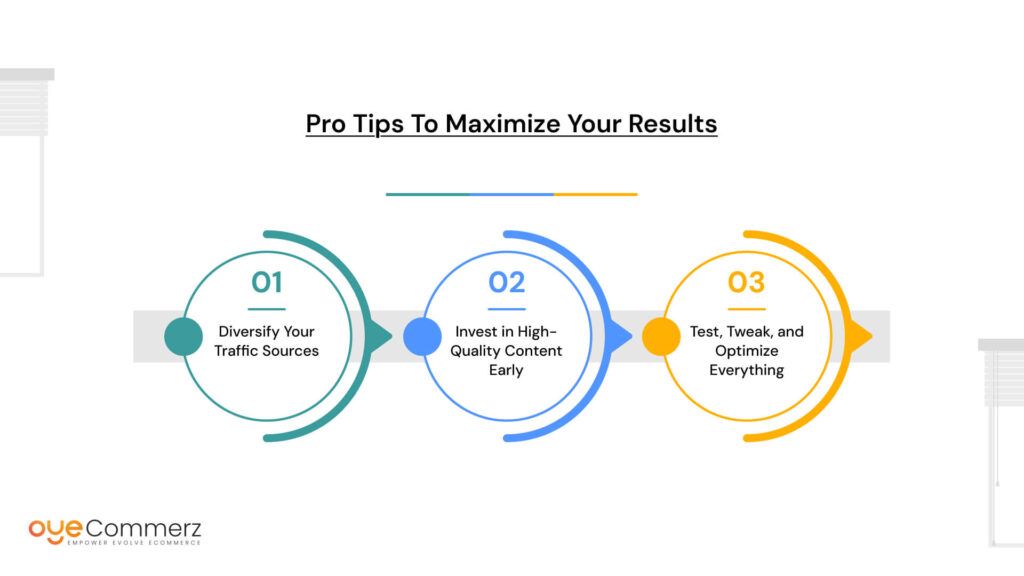
Getting traffic to your Shopify store is one thing, sustaining and scaling it is another. As you work through your marketing strategy, it’s easy to get caught up in trends, overlook fundamentals, or depend too heavily on one method. Below are some expert tips to keep your strategy balanced, and common pitfalls to avoid.
Pro Tips to Maximize Your Results
1. Diversify Your Traffic Sources
Don’t become overly reliant on a single channel. Many new store owners make the mistake of focusing solely on Instagram or Google Ads. But algorithms change, ad costs fluctuate, and platforms evolve.
What to do instead:
Build a multi-channel strategy using a blend of:
- Organic traffic (SEO and blogging)
- Paid campaigns (Google & Meta ads)
- Owned channels (email and SMS)
- Community-based growth (referrals and influencers)
This helps protect your store from sudden drops in traffic and ensures long-term growth.
2. Invest in High-Quality Content Early
Think of your content as a long-term asset. Well written blog posts, informative product descriptions, attractive videos, and social media content all contribute to visibility and trust.
Tip:
Use your blog to answer common questions, create comparison guides, and share buying tips. This positions your store as an expert and drives organic traffic over time especially when paired with SEO services.
3. Test, Tweak, and Optimize Everything
Digital marketing is never one-and-done. What works today may not work tomorrow. That’s why A/B testing is essential.
Regularly test:
- Ad copy and creatives
- Email subject lines
- Homepage layouts
- Product page CTAs
Use insights from analytics tools like GA4 and heatmaps from tools like Hotjar or Lucky Orange to see what users are doing and where they drop off. Continual testing ensures you’re always improving.
Mistakes That Hold You Back
1. Relying on One Traffic Source
This is one of the most common and risky mistakes. If 90% of your traffic comes from, say, Instagram, a change in the algorithm or your ad account being flagged could instantly derail your sales.
Avoid it by:
Spreading your efforts across at least 3–4 channels and consistently building owned assets like your email list.
2. Using Spammy Backlink Tactics
Yes, backlinks are important for SEO but only when they’re relevant, contextual, and earned from quality sources. Buying cheap links or stuffing backlinks into irrelevant directories can do more harm than good.
Play the long game:
Build backlinks through authentic guest posts, press mentions, partnerships, and high-value content that others want to share.
3. Skipping Analytics Setup
Without proper tracking in place, you’re essentially flying blind. Many store owners neglect analytics, and as a result, they have no idea which marketing channels are working or worse, they double down on tactics that are underperforming.
Always set up:
- Google Analytics 4 for user behavior tracking
- Search Console to monitor SEO health
- UTM parameters to track campaigns
- Shopify reports and marketing attribution
The earlier you get your data foundation in place, the smarter your future decisions will be.
Ready to Get Traffic on Your New Shopify Store?
At Oyecommerz, we specialize in Shopify SEO and creating custom solutions that drive traffic and increase conversions. Whether you’re just getting started or looking to scale, our team is here to help you succeed. Contact us today for a personalized strategy to boost your eCommerce success!
Let's build your custom Shopify app today!
Conclusion
Driving traffic to a new Shopify store isn’t about chasing quick wins, it’s about building a strong, balanced foundation. From optimizing your store for search engines and creating valuable content to leveraging paid ads, email marketing, and referrals, the key is to start with a strategy that suits your goals and budget.
You don’t need to master every channel overnight. Start small, test what works, double down on your strengths, and keep refining based on data. With consistency and smart execution, traffic and sales will follow.
Need help getting started with Shopify SEO or setting up high-converting traffic campaigns? Our eCommerce experts at Oyecommerz can guide you every step of the way.
Frequently Asked Questions
Getting traffic to a new Shopify store starts with building visibility across multiple channels. Focus on Shopify SEO to improve your rankings in search engines, use content marketing like blogs and product guides, and promote your store through social media platforms where your audience hangs out. You can also use Google Ads and Meta (Facebook/Instagram) ads to bring in paid traffic quickly. Start small, test what works, and scale the strategies that convert best.
To attract customers, you need to clearly communicate your value proposition and make your store easy to find and trust. Use engaging product pages, clear CTAs, reviews, and fast-loading mobile-first design. Leverage influencers, referral programs, and email marketing to build interest and repeat engagement. Content that educates or entertains like blog posts or social media reels can also help attract and retain your ideal customers.
You can increase traffic to your eCommerce website through a mix of organic, paid, and referral channels. Focus on:
Optimizing your site for SEO
Running targeted Google Shopping or Facebook Ads
Publishing valuable blog content
Engaging with communities on platforms like Reddit or Quora
Setting up email capture and marketing automations Over time, this layered strategy builds a consistent and scalable traffic flow.
People discover Shopify stores primarily through search engines, social media, and ads. Make sure your product and category pages are SEO-optimized with the right keywords, titles, and descriptions. Use Shopify’s built-in blog to drive organic traffic with helpful content. Promote your store on Instagram, TikTok, and Facebook, and consider using paid ads or working with influencers in your niche. Adding your store to Google Merchant Center also helps products appear in Google Shopping results.
Improving SEO on Shopify involves several key steps:
Keyword research for product, collection, and blog pages
Optimizing title tags, meta descriptions, URLs, and image ALT text
Creating internal links between product pages and blogs
Using tools like Yoast, Plug in SEO, or Smart SEO
Submitting your site to Google Search Console Also, regularly publish high-quality blog content and earn backlinks from relevant websites. For best results, consider working with a Shopify SEO agency like Oyecommerz to get expert support and technical enhancements.

